Editor
- FMA
- The Fabricator
- FABTECH
- Canadian Metalworking
Categories
- Additive Manufacturing
- Aluminum Welding
- Arc Welding
- Assembly and Joining
- Automation and Robotics
- Bending and Forming
- Consumables
- Cutting and Weld Prep
- Electric Vehicles
- En Español
- Finishing
- Hydroforming
- Laser Cutting
- Laser Welding
- Machining
- Manufacturing Software
- Materials Handling
- Metals/Materials
- Oxyfuel Cutting
- Plasma Cutting
- Power Tools
- Punching and Other Holemaking
- Roll Forming
- Safety
- Sawing
- Shearing
- Shop Management
- Testing and Measuring
- Tube and Pipe Fabrication
- Tube and Pipe Production
- Waterjet Cutting
Industry Directory
Webcasts
Podcasts
FAB 40
Advertise
Subscribe
Account Login
Search
A Q and A with SkillsUSA welding competition organizers
Volunteers discuss the ins and outs of the annual metal fabrication event
- By Rafael Guerrero
- September 13, 2023
- Article
- Arc Welding
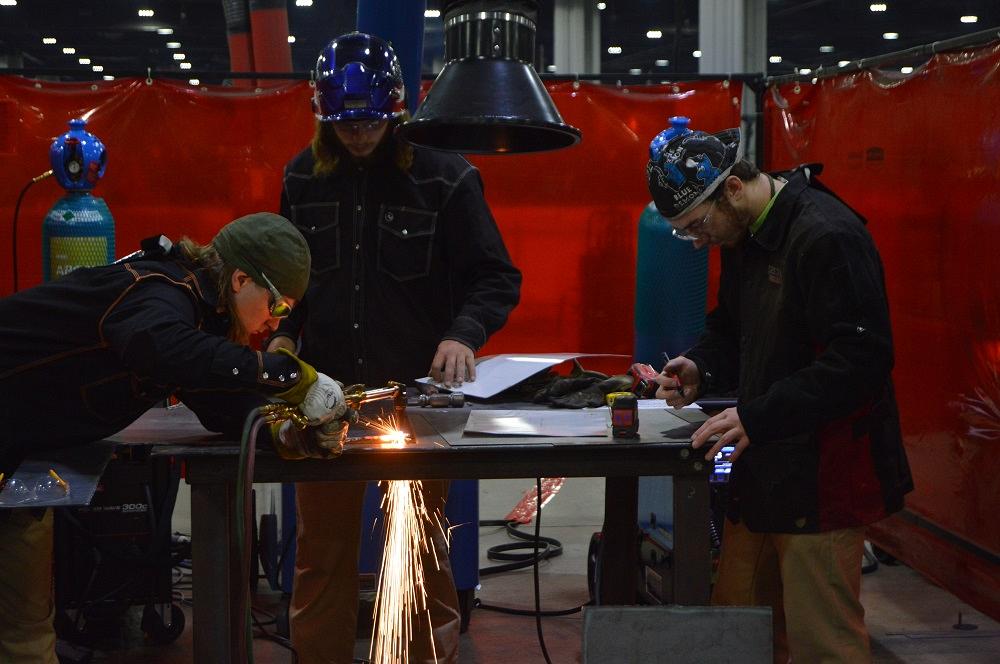
Contestants in the welding fabrication competition competed in groups of three to showcase their ability to fabricate, follow instructions, and work as a team.
Dozens of high school and college students from around the country showcased their welding and fabrication skills in Atlanta last June, hoping to be the best of the best at the 2023 SkillsUSA Championships.
For one week, these contestants demonstrated their abilities in three categories: welding, welding fabrication, and welding sculpture. The welding competitions were among 110 total skill-based competitions that took place during the week-long national SkillsUSA Championships, the centerpiece of the organization’s annual National Leadership & Skills Conference (NLSC).
Thirty high school and college/postsecondary students earned medals in the three welding categories, either as individuals or as teams.
Three organizers for the competition’s three welding-related categories discussed the event, the students and their work, and SkillsUSA.
Shanen Aranmor
Chairperson, SkillsUSA welding sculpture national competition
Founder/chief wellness welder, Weld Like A Girl
Yuma, Ariz.
The Welder: Can you describe the welding sculpture competition to our readers?
Shanen Aranmor: It is a multifaceted competition. Students prepare their sculpture prior to the contest. They use the same sculpture for the regional, state, and national contests. The only thing they’re allowed to do is clear-coat it and polish it up before coming here. The sculpture itself is completed.
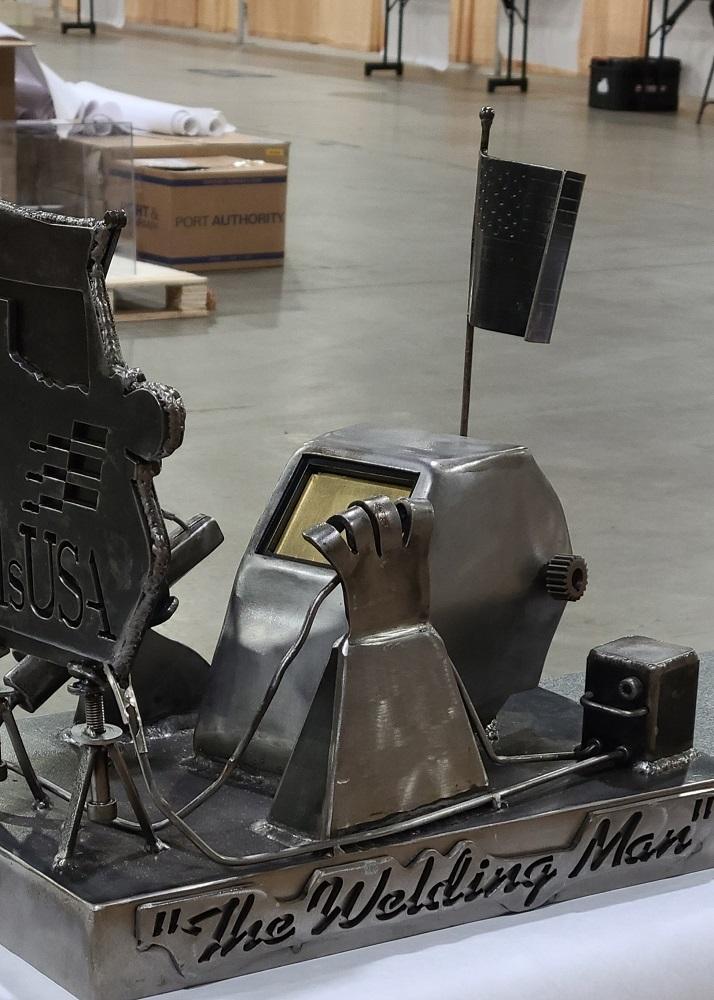
Contestants made their welded sculptures ahead of the national SkillsUSA Championships in Atlanta and presented comprehensive documentation demonstrating their work on the project. In 2023, competition organizers added a live welding portion.
When they get here, they have a five-minute interview and take a 50-point welding knowledge test. And then this year we’ve added a live welding portion to our contest. It's not being scored this year because it's new; when you introduce a major change, it needs to be for demonstration purposes only. Next year it will be part of the scoring.
TW: When you say live welding, what do they have to do?
SA: This year, we have two welding machines for use—two Miller Multimatic 220s. Next year, we will add the multiprocess Lincoln welders. And next year, we’ll also have plasma cutting and oxyfuel cutting. They go up to the booth and they are assigned a welding process that they are not made aware of—it's a surprise. They’re told if it’s stick, TIG, MIG, or flux-cored. We have PPE for them if they didn’t bring any. If they have their own PPE, they can use theirs. They step into the booth, set up the machine, turn on the gas, set the gas, dial it in, and perform the weld as prescribed by the judge.
Even though students take photos of their projects along the way and have photos of themselves working on the sculpture, sometimes they’ll say, “We did this,” and you're left thinking, “Hmm, I wonder who did that?” Part of [the live welding component] is to lend credibility to the fact they’ve done the work themselves. The other part of it is welding sculpture has always been off to the side. The welding competition chair Ed Norman and Martica Ventura from AWS have always been huge allies. They want to elevate sculpture to the same status as the other two contests. Welding fab, welding, and welding sculpture have always worked well together—why not have us weld like they do?
TW: What could the students do with their sculptures—and what couldn’t they do?
SA: They're allowed to use ferrous or nonferrous metals. They have a size requirement—it can’t be over 100 lbs. They can’t break any copyright laws. No paints or patinas or chemical etchings. They are allowed to clear-coat.
For colors, they can use heat to color it; they can’t use any chemicals. What they’ll sometimes do is use multiple types of metals—bronze for yellows, copper for reds or pinks or oranges. It is a welding sculpture contest, so even though they might form metal in other ways, we want it to be more welded than not.
They have a notebook, and they have to include photographs in it. If they grind their welds down, they have to document that.
TW: How did the sculptures turn out for 2023?
SA: I was amazed. Some of them are really well done. They're super polished; some have movement, which wasn’t a requirement.
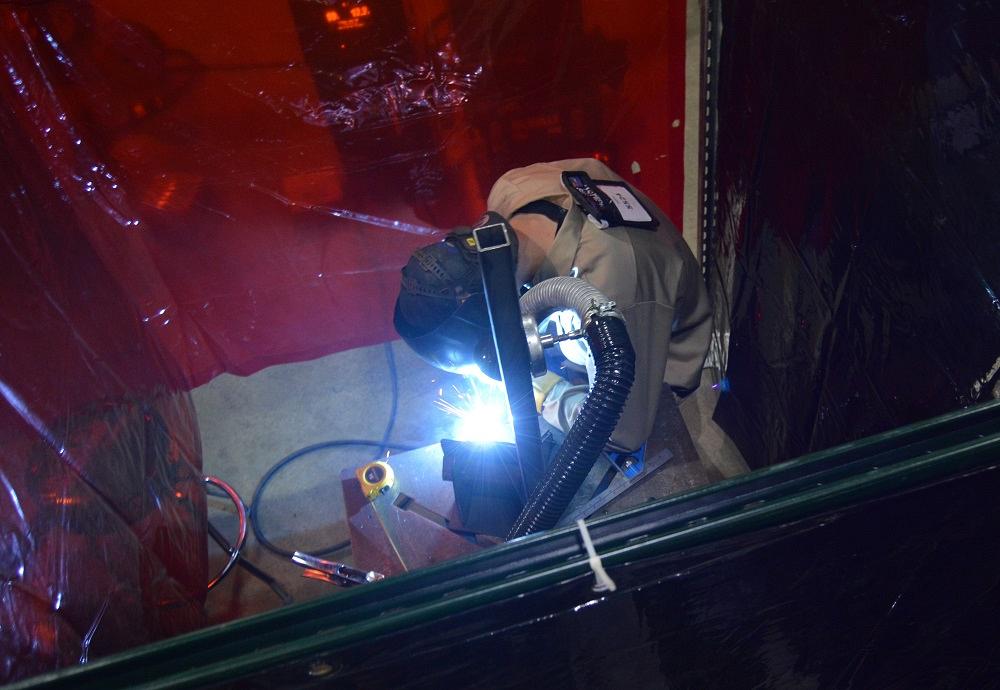
Dozens of the country’s top young welders and fabricators participated at the 2023 SkillsUSA Championships in Atlanta in June. The competition recognized the efforts and abilities of high school and postsecondary students in several skills and trades.
From what I've seen, there’s been some really creative use of materials. You can use ferrous and nonferrous metals, so some mixed them together and I think that was pretty interesting. Everyone who I've talked to has been like, “You raised the bar again this year.”
TW: What has this experience meant to you?
SA: I started in the welding industry because of competing in the welding fab contest ... I hadn’t planned on being a welding major as I’d already had different career plans; I was taking welding for fun.
For me, it is amazing that I get to stand up on the podium. Every single year, I get to hang the medals. It's better because most students get one or two chances to be on the podium. I get to be on the podium and hang those medals and see those smiles and tears of joy every single year.
Ashley Applegate
Co-chair, SkillsUSA welding national competition
Director of training, Kentucky Welding Institute
Flemingsburg, Ky.
The Welder: Can you describe the welding competition?
Ashley Applegate: They did GTAW, SMAW, GMAW, and FCAW. They had a limited amount of time for each process to assemble a small project according to the blueprint, put the welds according to the blueprint, and follow a welding procedure to make those welds. The students did a plasma cutting and oxyfuel torch cutting project where they had to cut various shapes out of a given plate, according to a layout drawing. Finally, they had to stand for an hour doing a visual weld examination, similar to a Part B CWI test.
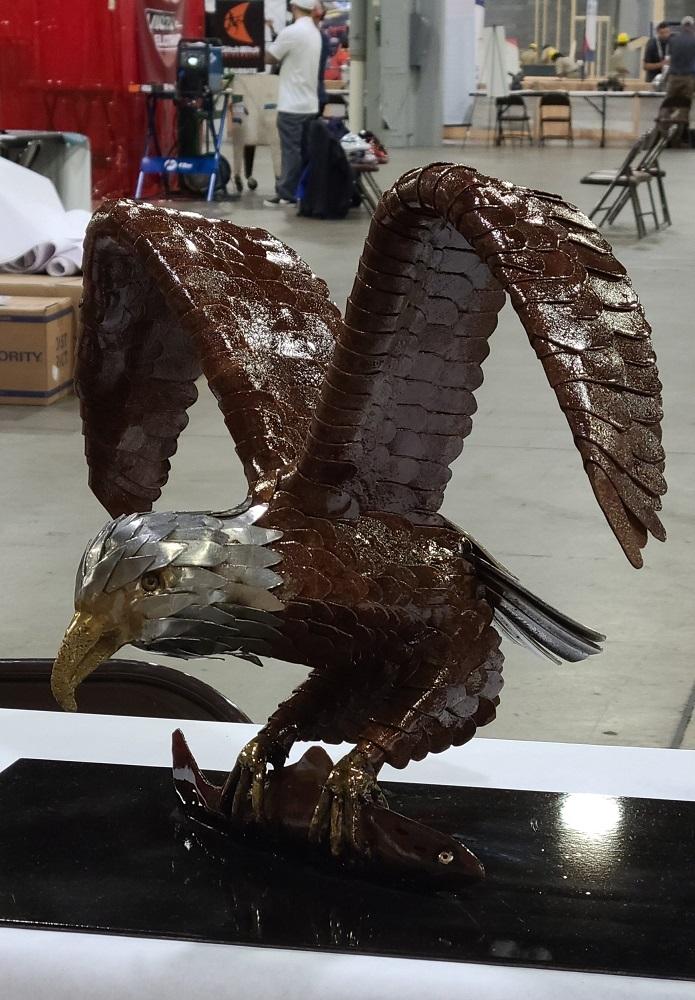
Aranmor said many of the pieces in this year's welding sculpture competition incorporated movement, which was not a requirement.
It’s an eight-hour day for each student; they're here all day long.
This competition is sponsored through a lot of partnerships: the AWS, Lincoln Electric, Miller Electric, Hypertherm, others like Vermeer and Airgas. Lincoln and Miller provided the welding power sources. This year, Hypertherm provided the plasma cutting equipment and Hobart provided a lot of the filler metal along with Lincoln.
TW: What equipment or tools are available to them while competing?
AA: Lincoln and Miller, they swap out each year. One manufacturer will support the wire welding processes and the other manufacturer will do TIG and stick, and next year they’ll flip. They will bring the latest, best equipment they have. I hope that when the student makes those awesome welds, they go back to their advisors or instructors and say, “Hey, we welded with a Lincoln or Miller—we should get some of those for our school.”
As far as personal tools are concerned, we have a short tool list of what each candidate will bring. They just bring the basic tools you will find in any welder’s bucket.
TW: How do you grade and review their work?
AA: The problem you'll find with a welding competition is that [scores] are based on an opinion. Two judges may look at a weld and give it a score and there’s always a debate. The scoring system created by this committee has been exponentially changing welding competitions across America. When judges look at the weld, that weld is evaluated based on a code. Every weld is evaluated the same—it's measurable and defendable. If anybody has a complaint, “Well, I like this weld better than that weld,” it’s not the judges’ opinion—they don’t like anything. If you look at welding code, the words pretty or ugly aren’t in the code book. I've seen ugly welds pass and pretty ones fail. This welding competition is based tighter than normal welding code. If we based this on a code we’re familiar with, like D1.1 or ASME Section IX, we'd have 50 ties.
TW: How many years have you volunteered for SkillsUSA?
AA: This will be my 31st year volunteering. I started right after graduating tech school, judging local events and running events and then got involved in chairing state events. And then I eventually got involved at the national level.
When you see the arena [on closing/awards night], there’s so much excitement in the atmosphere. When a state gets called and a winner gets called, it’s not just two or three people clapping, it’s their entire state because they got a medal. The look on their faces whenever they make good welds and get recognized is exciting.
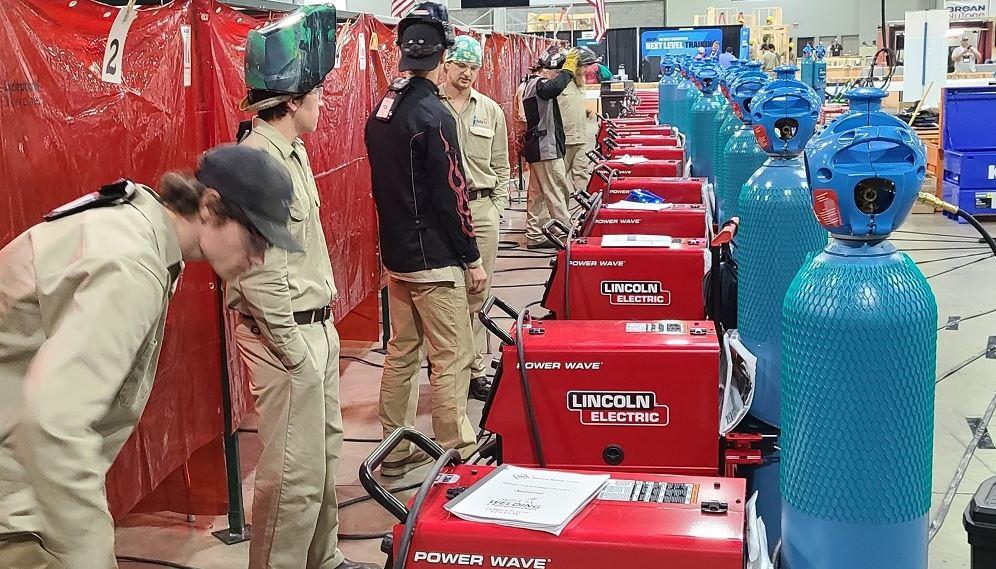
Companies and organizations provided equipment and sent volunteers for the welding-related competitions at the 2023 SkillsUSA Championships in Atlanta. Lincoln Electric and Airgas (pictured) were among the businesses that provided equipment to the welding competition.
TW: What would you say to someone who is interested in getting involved in skills competitions?
AA: Absolutely do it. If you’re an instructor and want to get involved, reach out and find a place to compete. If your school is not a Skills chapter, become a Skills chapter. When your students compete, it’s similar to going for a job test. If you’re an industry partner, get involved. We need industry to get involved so we can continue to have awesome events like this for the next generation of welders.
Tom Kostreba
Chairperson, SkillsUSA welding fabrication national competition
Erie High School welding teacher
Erie, Pa.
The Welder: Can you describe the welding fabrication competition?
Tom Kostreba: This competition is set up with a three-man crew. We try to find them a project the crew can build in six hours. It's set up to test them in the areas of cutting with oxyfuel and welding with GMAW, pulsed GMAW, and GTAW. They have to know blueprint reading; they have to be able to think and decide how to cut the material. There’s certain areas they have to figure out, like problem-solving and using math. We're really hitting a lot of areas that they have to learn when they go out into the fabrication world.
TW: And what did they fabricate during this competition?
TK: They made a charcoal grill. It's built so we can donate it and put it into the ground about 1 ft. It's something a camp can use—people can stop and put charcoal in it, light it up, and do their cooking. Caterpillar designed and got us the blueprints for it. Vermeer donated all the materials for it. The goal at the end is to make products that don’t get thrown away. If we can make something we recycle or reuse, it would make more sense.
TW: What other projects have been done in recent years?
TK: They’ve made donation boxes, they’ve made rocket stoves, we’ve built the benches to use in the booths, they've built toolboxes. Last year, they did portable [welding] curtain holders.
TW: What tools or equipment do they have at their workstations?
TK: They have drills, hand grinders, welding machines, oxyacetylene torches, clamps, vice grips, pliers, hammers, squares, levels—anything you would use in a fab shop.
TW: Is there a reason for the three-person teams?
TK: Three works out well. You have one person laying parts out, one person cutting, and ideally one person welding.
We're finding that the younger generation work like crazy and are driven. I think they’re about the same as any other generation before, it’s just a matter of finding motivation. This event showcased how excellent their work ethic is.
TW: Do you believe the competition helps to promote jobs in industry?
TK: Industry believes in it. All my materials were donated this year. Companies spent a lot of money and a lot of time to help me make a better contest. It does a great job promoting industry.
[Competition] has a big effect on our industry.
About the Author

Rafael Guerrero
2135 Point Blvd.
Elgin, IL 60123
(815)-227-8242
Rafael Guerrero. was named editor of The Welder in April 2022. He spent nine years as a journalist in newspapers in the Midwest and Pacific Northwest, covering topics and communities in central Illinois, Washington, and the Chicago area.
About the Publication
subscribe now

The Welder, formerly known as Practical Welding Today, is a showcase of the real people who make the products we use and work with every day. This magazine has served the welding community in North America well for more than 20 years.
start your free subscription- Stay connected from anywhere

Easily access valuable industry resources now with full access to the digital edition of The Fabricator.

Easily access valuable industry resources now with full access to the digital edition of The Welder.

Easily access valuable industry resources now with full access to the digital edition of The Tube and Pipe Journal.
- Podcasting
- Podcast:
- The Fabricator Podcast
- Published:
- 04/16/2024
- Running Time:
- 63:29
In this episode of The Fabricator Podcast, Caleb Chamberlain, co-founder and CEO of OSH Cut, discusses his company’s...
- Trending Articles
Sheffield Forgemasters makes global leap in welding technology

ESAB unveils Texas facility renovation

Engine-driven welding machines include integrated air compressors

How welders can stay safe during grinding

The impact of sine and square waves in aluminum AC welding, Part I

- Industry Events
16th Annual Safety Conference
- April 30 - May 1, 2024
- Elgin,
Pipe and Tube Conference
- May 21 - 22, 2024
- Omaha, NE
World-Class Roll Forming Workshop
- June 5 - 6, 2024
- Louisville, KY
Advanced Laser Application Workshop
- June 25 - 27, 2024
- Novi, MI


























